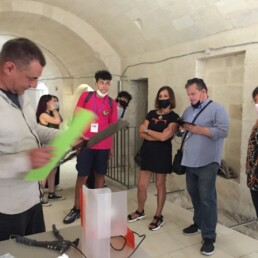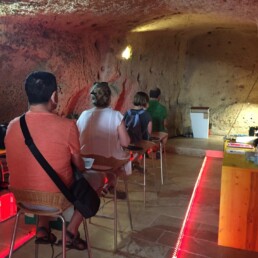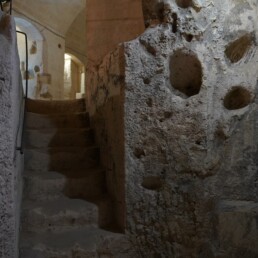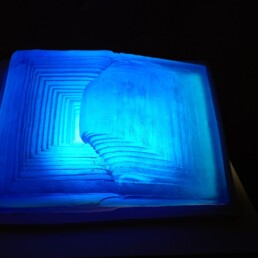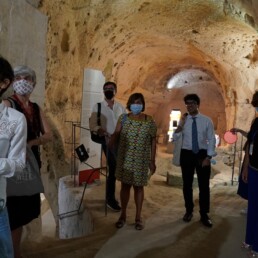Ancona, Firenze, Palermo, Varese, Venezia, Udine.
In mostra
A series of works that the sculptor Marta Palmieri made starting from the recovery of waste materials coming from glass processing. These creations are made by a vitreous mass which undergoes an expansion process during firing. The outcoming material looks like a solidified foam and physically keeps rigid and light. It’s the body of objects whose shapes seem to follow the laws of organic matter. The colors, through the light, return strong chromatic contrasts.
These works have primeval shapes and the constituent material is definitely the protagonist and the architecture of the geometries helps to restore an archaic character.
As the sound effects, these peculiarities revolve around the primordial nature of the elements, its minimal components, rhythmic and chromatic textures aimed at evolving towards stochastic systems.
Marta Palmieri was born on 29 March 1973 in Ancona, where she currently lives and works. After having attained a diploma at the Ancona State Art School in 1991, she studied at the Academy of Fine Arts in Urbino and graduated in Sculpture in 1997.
During her studies she experimented with various materials: plaster, wood, iron, concrete, plastics and yarns. In those years she won the “Edgardo Mannucci” Sculpture Prize. The years following her studies at the Academy were entirely dedicated to ceramics. In 2009, at the Pesaro Contemporary Ceramic Art Competition, she won second prize and met Gian Carlo Bojani. In the following years she worked on a number of projects with him: in Fano for the Sangallo Fortress, and in Vilnius. Giancarlo Bojani would also curate some of her solo shows. Finalist in the Faenza prize on many occasions, from 2017 until today her work has won considerable recognition, as finalist at the biennial shows in
Manises (Spain) and Aveiro (Portugal), and in the competitions of Westerwald (Germany) and Saint Quentin de Poterie (France), Beijing and Jingdezhen (China). She has taken part in group shows linked to the world of design, both in Italy (International Furniture Show, Milan) and abroad (Showroom 304 Hudson in New York). In the latter city, her works are exhibited by the Hostler Burrows Gallery. Her pieces are also shown at the Permanent Museum Collection at the Quanzhou Porcelain Road Art Development Center, Beijing, the permanent collection at the Tsinghua University Museum, and the permanent collection of the Ceramics Industrial Heritage Museum, Jingdezhen, China. In Italy, her work is shown at the Castello Episcopio Ceramics Museum in Grottaglie, at the Civic Museums of Pesaro, and at the Fondazione Accademia in Este. They are also part of the Bojani Collection founded in 2015 at Palazzo Brunori Corinaldo.
A work in three acts that explores the power of encounter and intersection, between disciplines, traditions and cultures.
Installations with a Mediterranean soul that reinterprets the relationship between design, light and sound in three different essential moments, connected but independent in their fruition.
The cisterns of the stones of Matera, with their ancient and cosy atmosphere, express their genius loci through suggestion, in an intimate and cosy spatial succession, exploring the blurred boundary between art and design in favor of an experiential project that involves the viewer in a newfound interaction with the space.
The first act investigates the relationship between natural and artificial light through a luminous object with a light structure that integrates a system of mirrors to change life between day and night, also interacting with the natural light that passes through the cistern.
In the second act, sound becomes the protagonist in its immateriality: it is here that the spectator is invited to move and play with the sound waves in order to modify the exposed object without touching it.
Finally, the third act is a tribute to Franco Battiato, offering a moment of reflection on the present and a global wish for rebirth and light.
The authors
Studio Forward is an architecture and communication agency founded in 2004, made up of architects and creatives specialized in architectural design, interior design, exhibit, visual, graphic, movie, web and interaction, who, looking at international models, base their work on the conviction that only the interaction between different design disciplines is the foundation of an effective creative concept.
Studio Forward’s exhibit department works with models in which multimedia and interaction are necessary tools for the visualization of constructed narratives, and this is always achieved by relating the object of the installation to the place – the space – surrounding it.
Among the most significant works VAS – Videoart Sicilia, Palazzo Bonagia, Palermo (2007); 150 Italiae, Lombardini22, Milan (2011), Humanitas, Palazzetto Agnello, Palermo (2016).
Along the course of New Materials Technology held by prof. Carlo Antonelli in Poliarte Academy in Ancona, the students attending the 2nd year of Industrial Design course worked on designing and assembling an electroacoustic device for the sound diffusion.
The final step of the course was represented by the production of five operating prototypes made of by each student.
After checking the proper functioning of each device, taking in account that three of five students were acknowledged about musical language and were playing music, the step ahead was to arrange a performance that could emphasize the aesthetical and acoustic features of these devices.
The performance’s purpose is to explore the potentiality given by the sound arising from multiple sources and how those have the power to generate articulated environmental sound effects.
The sound from each speaker is played and managed using a computer that run a specific designed score. The acoustic flow of the sound has been conceived for being manipulated and contaminated during every session by the mean of several instruments.
Acoustic elaborations wrapping around the primordial sound’s nature, spinning around its elementary bases and to rhythmic and melodic weavings tending to evolve to stochastic implants.
The sound equipment by which the acoustic scene is controlled is also connected to a lighting system that will interact with visual effects synchronized to the acoustic system.
- Ivan Belardinelli designed and produced “Cajon”. He plays synthesizers, percussions and drum machine.
- Giuseppina Cioffi designed and produced “Gyom”. She controls the lighting system.
- Marco Nicola De Filippis designed and produced “Shelf Sound”. He controls the lighting system.
- Alessandro Guidobaldi designed and produced “Mammoth”. He plays keypads.
- Alessandro Tarsi designed and produced “528 Sound”. He plays electric bass and manages the mixer.
- Carlo Antonelli directed and supervised the whole project.
FLORENCE DESIGN WEEK project in collaboration with REDO ‘FIRENZE
A possible relationship. Design, art, craftsmanship
Talking about design and the relationship with craftsmanship might perhaps seem to some almost a heresy. The double thread existing between the disciplinary field of design and the industrial production model is well known, especially in the Milan area since the mid-fifties, which has made a significant contribution to the cultural and economic growth of Italy and has projected, even abroad, the most positive image of our country.
Therefore the design – industry relationship appears to be acquired, inseparable and exclusive.
However, it being understood that this relationship has often reached (and still reaches) very high expressive heights, it seems to us that it is not the only way forward. It would be enough to remember that, at its birth, design was related to an idea of industry which, although already started on the technological choice, was quite far from the model to which we refer today, resembling a lot, due to the still mandatory manual skills of man, to the artisan enterprise.
This reflection alone would be enough to venture a possible reconnection between design project and artisan enterprise. If we then retrace the experiences of the design culture of recent years, starting from the artistic avant-gardes of the early twentieth century and then passing through that close design-industry relationship consolidated around the middle of the century, we discover the existence of different experiments which, almost like splinters gone mad, seemed to deny that very relationship.
Avoiding to mention other cases (such as the contributions given by artists and designers) instead we are obliged to remember that precisely the 80s of the century just ended, a profound crisis gripped the industrial production of the sector, pushing companies to implement new production strategies. In those years, it was the beginning of what will later be defined “post-industrial era”, the basic criteria were modified and redefined, proposing the elimination of the assumption of a production for a mass market, to replace it with a differentiated production strategy and high aesthetic quality aimed at a niche market. It is therefore possible and legitimate to speak of a direct relationship between the creative moment, the territory of architects and designers, and the artisan productive moment.
By proposing for the next edition of MATERA DESIGN an exhibition event linked to highlighting, through light, the workshops, the production of artisans through a path of the Florentine creative scene, with the proposals of these contemporary designers-artisans, in collaboration with the Maestro Valerio Salvadori and REDO ‘FIRENZE.
Torrebianca, Rossoblù, Zona Notte are the lamps designed by Giorgio Ceccotti for Light Up Italian Design Weeks. They are handmade, one by one, out of PMMA waste (polymethylmethacrylate, also known as Plexiglass). The scraps are of new material, still protected by adhesive sheets, of assorted sizes and colors. The designer bends them by hand, using an industrial phon, in order to heat the sheet only where he wants. He then assembles the different pieces by holes and aluminum rivets in order to obtain a functional composition.
The theme of Udine Design Week 2021 is Complex Simplicities. The concepts that we propose to think about starting from the choice to exhibit these objects are:
• it is good practice to know how to build complex objects starting from simple pieces;
• plastic is a precious material that should not be lost but recycled or reused, as in this case;
• design is a central discipline to know how to organize matter around an object by simply drawing on a pool of shapes and colors.
Giorgio Ceccotti has worked as a free-lance industrial & product designer since 1990 in Milan, London, Los Angeles. In 2001 he founded R.E.M.O. (Ricerca Estesa Meraviglioso Organizzato), a study committed to sustainability and Re-use by designing and self-producing one off pieces and small series of furnishings and accessories, made of natural or environmentally friendly materials, production waste, by-products. He teaches Design Model Making at the Academy of Fine Arts in Rome.
Imagine Venice a city built on piles in a special atmosphere between sky and water. The installation in the Matera “sassi” draws attention to these elements and transports us to a millenary history in which glass is the protagonist and over the years has become the basic element for the construction of large chandeliers that still decorate palaces, hotels and mosques. Murano was a major production and export centre. The book, made using the technique of glass fusion, proposed by Anita Cerpelloni, seems to tell a thousand-year-old story. Books of words have been transformed into backlit transparent glass books. The work is entitled “Parole NONdette – No Books – Transparencies” and testifies to the contemporary transformation of books into display objects no longer in use. Further suggestions on the glass surfaces are given to us by the LED lamp that backlights the composition of the glass plate revealing the luminous portal that the artist has composed with the glass rods. The light enhances the transparency and colours of the glass in a magical symbiosis. The project was born in the context of Maestro Eros Raffael’s workshop for glass fusion creatives held in 2019 at the graphics and communication technical institute.
Venice Design Week, which takes place from 9 to 17 October 2021, allows a journey between ancient and contemporary. Among the various routes, the glass route is proposed to bring the public and creatives into contact with particular productions that are still Murano peculiar, you enter furnaces, including Fornace Galliano Ferro, Fornace Mian, Wave Murano Glass, ready to dialogue with professionals to create custom projects of great dimensions. Over the years, synergies and new projects have arisen from these island encounters that make the network offered by design weeks a real contact moment and the beginning of relationships that are consolidated with realizations all over the world.
VARESE DESIGN WEEK IN MATERA WITH A PROJECT OF THE VARESE BASED DESIGNER STEFANO ZELLNER
VARESE DESIGN WEEK is an international event that promotes design, culture and territory through a path of enhancement of design and culture aimed at stimulating the interest, not only of insiders, but of a wider audience, curious and interested in beauty, the search for taste and the revaluation of the city in its most significant places. The protagonists of the event in Varese are designers and companies that have the opportunity to present their achievements, in an important showcase of international breath and within a circuit strongly linked to creativity, design and production of industrial and craft objects. Varese Design Week is a project born in 2016 with the aim of overcoming the idea of the inaccessibility of design as a “matter” of interest to a few.
The narration of the creative process must be a vehicle to raise awareness of the most emerging current issues such as inclusion, environment, sustainability.
In 2021, the year of rebirth, Varese Design Week focuses on young designers, protagonists of a new era of Italian design, projected towards the challenges of the future, in the awareness of the original value of the made in Italy design.
In Matera it experiments the association and the union between two materials, wood and concrete, that with their characteristics support the light and its reflections. With the creations of the designer Stefano Zellner from Varese, he chooses for Matera Fucina Madre a versatile and innovative design with simple lines, in which functionality and beauty are combined.










